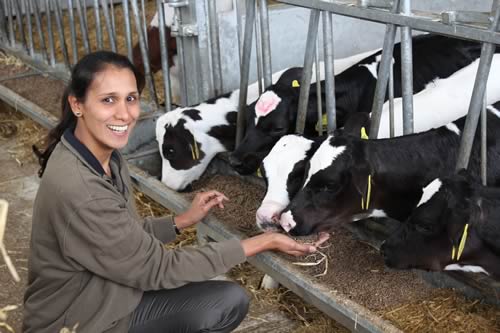| 2018-01-17 |
Caring for Calves Over Winter
There are some ‘added extras’ in caring for calves over winter – just like getting a vehicle ready for the colder months, according to Cargill’s calf and heifer specialist Bianca Theeruth.
“As temperatures fall, calves need extra energy for maintenance, so we need to feed more to avoid this energy being diverted from their growth requirements.”
Bianca Theeruth
The temperature range - or thermoneutral zone – for calves is typically between 10°C and 25°C. Within this, the calf will generally maintain its body temperature and requires no additional energy to keep warm.
“But this temperature range varies with the age of the animal, and in winter we are particularly concerned about the lower end; the lower critical temperature,” adds Ms Theeruth. “For calves under three weeks old, the lower critical temperature is between 10° to 15°C. Below this, the calf will use its energy reserves to maintain a core body temperature of 38°C to 39°C, diverting it away from growth.
“For calves of more than three weeks old, the lower critical temperature is between 5°C to 10°C, due to its more advanced rumen development that generates heat, its higher energy starter feed intake and more internal fat stores.”
Figure 1
Figure 1 shows the extra energy requirements above maintenance (7.87MJ/day) for calves up to three weeks old and of more than three weeks old as temperatures fall. If this extra energy isn’t supplied, then calves ‘burn’ body fat reserves and then muscle tissue. This causes weight loss and depresses the immune system.
“As a rule of thumb, for every degree the temperature drops below the calf’s lower critical temperature, the energy required for maintenance increases by 1%. It is important that farmers recognise this and adapt the calves’ diets so they don’t run short of energy for growth. Nutrition is first line of defence against the cold.”
In the first three weeks, when starter feed intakes are minimal, the extra energy must come from increasing milk or milk replacer. Ms Theeruth outlines a few routes farmers can take to increase energy intakes for young calves:
-
Increase calf milk replacer by 100g per calf per day split between feeds. No more than 900g per day of calf milk replacer should be fed.
-
Feed a ‘high’ 20% fat milk replacer
-
Increase the volume of liquid, say from five to six litres per calf per day, across two feeds. A third feed could also be introduced with a maximum of 900g of powder in six litres of mixed milk per calf per day i.e. split the total concentration and volume into three feeds instead of two. But bear in mind that this may hinder starter feed intake which can delay rumen development
“Management is equally important,” says Ms Theeruth. “Milk should be fed at or slightly above body temperature and a texturised, coarse and muesli type starter feed will encourage intakes. And calves need fresh, clean water from day 1.”
Calf accommodation is crucial and in winter poorly ventilated and draughty accommodation will create problems. Moving air and fresh air are needed as much in winter as summer.
Dry bedding is one of the most important factors in calf management. A dry, deep straw bed will provide insulation; the calf will create a nest effect. Calf jackets for young or sick calves will help in retaining body heat.
“A few small changes if necessary and upping the calf’s energy supply as temperatures fall will help to avoid pitfalls that can throw the calf off its growth target. Keeping calves warm, well-fed and comfortable will pay dividends.”



